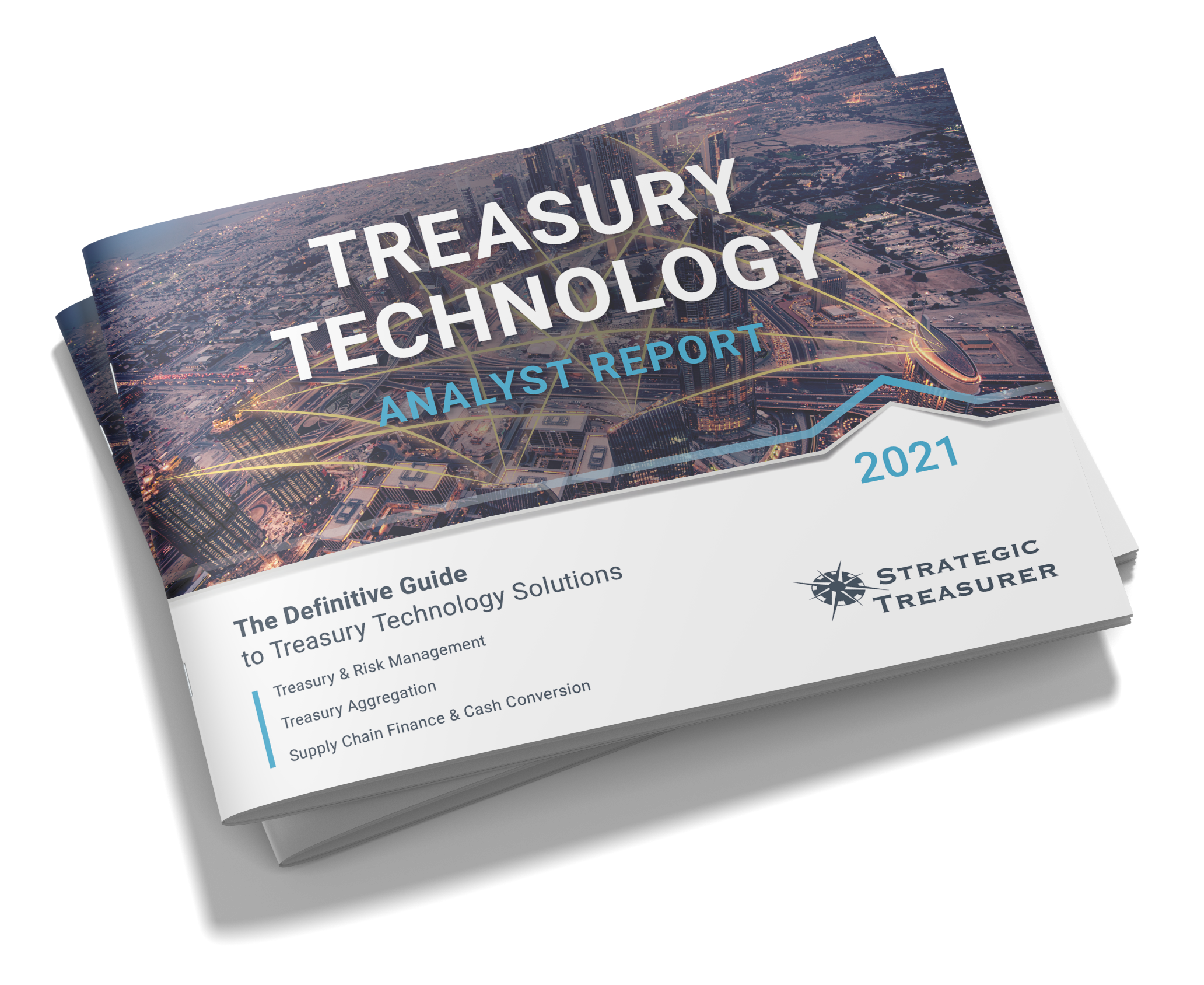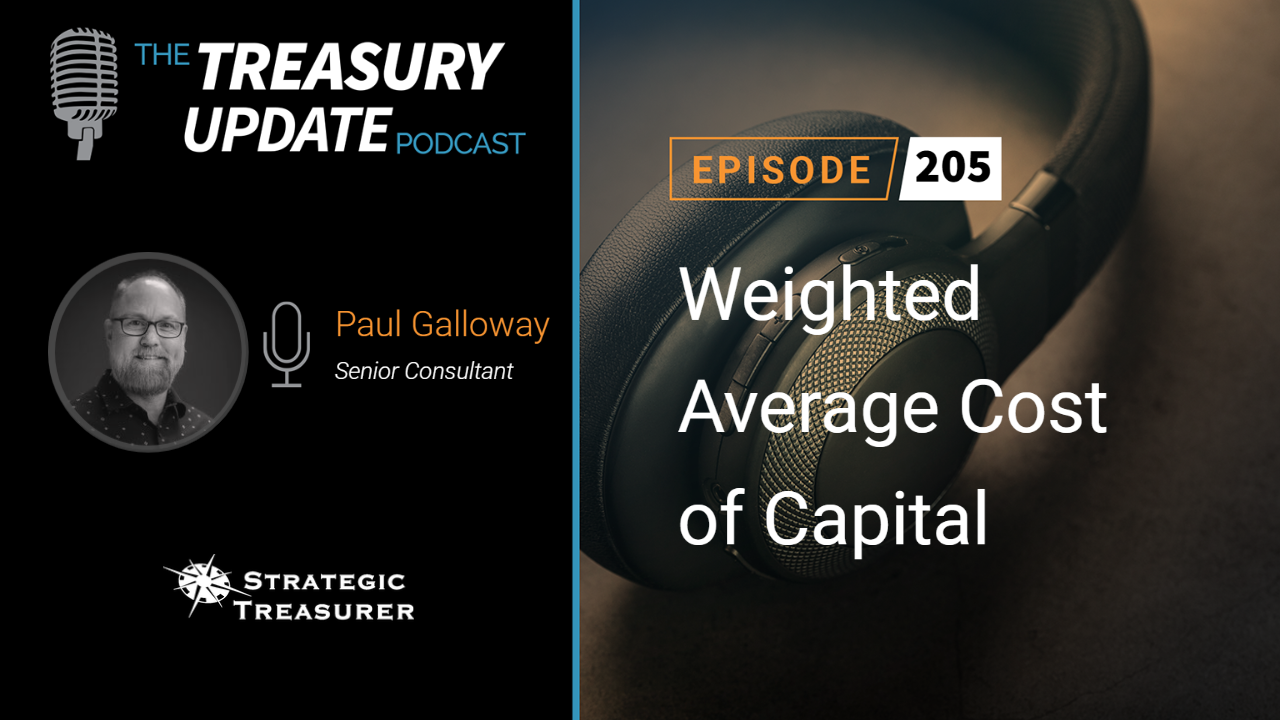
Episode 207
What Are the Disadvantages of Hurdle Rate?
Investments require a certain minimum rate of return to make them worthwhile. On this podcast, Craig Jeffery and Paul Galloway continue their discussion on investment returns with a specific look into Hurdle Rate.
Download our recent eBook on Payment Security & Fraud Prevention – The Principles of SECURE CLAMPS
Host:
Craig Jeffery, Strategic Treasurer


Speaker:
Paul Galloway, Strategic Treasurer


Episode Transcription - Episode #207 - What Are the Disadvantages of Hurdle Rate?
Nicki Gillispie 0:05
Welcome to The Treasury Update Podcast presented by Strategic Treasurer, your source for interesting treasury news, analysis, and insights in your car, at the gym, or wherever you decide to tune in.
Craig Jeffery 0:20
Welcome back to The Treasury Update Podcast, Paul. Good to have you back again.
Paul Galloway 0:25
Good to be here.
Craig Jeffery 0:27
I am looking forward to today’s ongoing discussion about returns. Today we’re gonna be talking about hurdle rate or required returns. Maybe you can give us a quick recap of the other topics that we spoke about just the return on capital, return on equity, those types of things.
Paul Galloway 0:45
Yeah, absolutely. Our prior podcast we talked about the return on capital and return of capital the concept of companies will make capital investments internally within the organization to give a certain level of return that they require. We didn’t talk about required returns but we’re talking about that today. And so, they will deploy capital in new products, systems, people, perhaps mergers and acquisitions or something else to generate return. And once they’ve exhausted all of their options, then they return the capital. And so, we’ve talked about those concepts last time, the risk return on capital return on invested capital, return on equity, or various concepts of our own return. And so today like to dive a little deeper into an internal company, notion of return typically called hurdle rate, which is kind of what it sounds like. You know, there’s a certain level that you have to get to or above in order to make an investment. So, we’ll talk about what that means.
Craig Jeffery 1:56
Yeah, so this concept of a hurdle rate. This is used in what situations? This is used for project work, general view of capital, or how would you describe how most companies are using this rate that you need to get over to make it worthwhile?
Paul Galloway 2:14
It can be tied to a variety of things. So, it could be project work could be tied to something that generates a return based on investment and systems that make things more efficient for people for generating more sales. It could be products, so you invest in the products or services that you distribute as a as a company that generate return it could be mergers and acquisitions mean you have a corporate development team that goes out and looks for opportunities to dovetail certain products, services, or organizations, or reach distribution, something of that nature that will generate additional return to the organization.
Craig Jeffery 2:59
Okay, so as we as we think about this, this hurdle rate, if we’re looking at invest in new line of business, is that something we’d look at a hurdle rate we need to get over 15% or 15% return rate or it’s not worth doing?
Paul Galloway 3:15
Yeah, I’ll take one step back and then kind of took a step forward. So, most people when they look out in the markets at an organization of companies, you would just make a real simple, but the Yahoo Finance or Google Finance you look up a company, publicly traded company. You can get information on the organization, I’ll have all kinds of different metrics, and one that is key that a lot of people will look at is what’s the return on equity. We talked about that when we talked about weighted average cost of capital. We also talked about it for return on return of capital. And so, when you think about that level, let’s say an organization has our return on equity of 10%. If I am a CEO, president of a company, and I’m looking at a line of business I want to buy. If I went out and said hey guys, you know we got to get at least 10% Because that’s what our return on equity is. Well, that may not be a fair level to compensate for risks associated with integration and factors that are unknown to us about the organization. Even though we do due diligence on the company. It might not mean that we know everything. Once we acquire a company, what a lot of organizations will do, I will say, a minimum we have to get X percent and so let’s say use 15%. Let’s say it’s 15%. So, if I’m doing an acquisition business that would be within my industry is something that I really know very well in terms of their product and service. 15% may be the right level for me. Now, there could be situations where we make an investment in an organization where we really don’t know the industry very well. But they complement our company and what we do and so we want to do an acquisition because complementary businesses could be very valuable, but we may apply a higher hurdle rate in the estimate because there’s risks that we just don’t know about. So maybe it’s 18%. And what happens in those instances is when you’re looking at the cash flows that could potentially be generated by that organization by acquiring it, compared to the investment you make up front or post acquisition because sometimes there’s payment you make post acquisition, you look at those cash flows, and you apply a discount rate to those cash flows. In this case, 18%. Is are you going to have a net present value that’s greater than zero? You’re trying to be zero because if it was 18%, well, then the NPV will be zero, which would mean that your internal rate of return based on those cash flows will also be 18%. Because that’s why an IRR is just the discount rate which cash flows will be equal to zero and discounted. There are different ways you can approach those hurdle rates. So, to say 15% is the only rate that you’re going to use, I think is not always the best approach because there may be other factors that impact the value of the organization you’re looking to acquire.
Craig Jeffery 6:35
So, let’s apply this to a couple other situation or at least one other situation. You’re putting in a system. Okay, so then maybe there’s two aspects of this. You’re putting in a system that helps you comply with regulations. So, there’s an aspect where it’s required, how you do it, how much you spend may vary, right? You have to comply, but there’s different ways of compiling. So, I guess one aspect when you’re looking at a project, whether it’s for compliance, or it’s just for efficiency, how would you distinguish between people talking about hey, it’s the ROI of a project, and does it meet our hurdle rate when you’re looking at projects? How would you talk through those two different terms for evaluating putting in a system?
Paul Galloway 7:19
Yeah, so it’s a little bit different than what we talked about before. Putting in a system, there’s a couple of things that can come to mind systems can generate deficiencies in current processes that are being done. So, in the event that you have regulatory requirements or some other legal requirement, says, “Hey, you got to comply with these particular codes or laws or regulations”. You may have people that are currently working in roles or positions where they’re working on compliance factors. And it could be a very manual process. Could be something that’s very time intensive. And there is a certain cost factor associated with that. So, when you’re looking at these projects, to try to look for ways that you can gain efficiencies, either in the process or through reduced costs, reduce time, reduce full time equivalencies or people’s time where you can redeploy those resources to something else. Because of this text last time, you’re looking at a couple different factors combined together against the cost of doing something that you have to do see, “Hey, can we meet or exceed the costs of doing this project over an extended period of time and save ourselves in terms of costs and efficiencies?”
Craig Jeffery 8:48
To the idea that there’s a hurdle or maybe perhaps a standard hurdle rate you provided some guidance as to perhaps 15% might be the common rate and there’s something a little farther afield where you have to account for a greater risk of realizing all those benefits. You might move into 18% or at least that’s what I remember of your example there. How does having this standard array, help people in the company evaluate activities? Is this a finance exercise? Or is there something else that this provides a finance mindset to the company? How would this be useful?
Paul Galloway 9:28
So, I mean typically when you talk about hurdle rates in themselves, it’s really a finance mechanism. Now, when it comes to evaluation, there’s a lot of other factors that go into it. So, the finance evaluation is one component, and it can be a very important component. And sometimes it can be the make-or-break decision on whether you go forward or not depending on what the numbers tell you. The other things that come into play are more of the qualitative aspects of making a decision. So, there can be qualitative aspects that are quite important, because it could be that either a project or an investment product or line of business or merger or acquisition positions the organization in an area that makes it better suited for success down the road and that can have a lot of value that is not derived and the cash flows or the finance side of things, when you’re looking at those particular items. So, qualitative aspects could make a difference and are important factors. Other things that you want to consider is obviously impact on people. Impact on resources. How you’re going to be able to make you generate a product and service. How are you going to distribute that? You also want to think about, let’s say it’s an M&A transaction. What are the integration aspects associated with that? Are there factors that we haven’t consider? You could go on and on on all kinds of different things but ignoring the qualitative aspects in addition to quantitative or the finance side of things, I think would be a mistake by companies.
Craig Jeffery 11:16
Sure. So, as we think about this topic of required returns and draw the conversation to a close, anything else that we should know? Or maybe you want to provide a summary of, What’s the purpose? And is there anything else that we should be contemplating for identify or methods of identifying what’s an appropriate hurdle.
Paul Galloway 11:38
So, there’s a couple other things that we didn’t talk about though I’ll just use as examples to kind of close out. So, there are opportunities that organizations engage in where a particular product or service is very new to the industry, and perhaps to the public, or it could be something where it’s super high risk, the chance of return or getting your capital back is low. The ability to sell off a particular business or product may be relatively low. Or could be a liquid, in those instances where, no, let’s say, you’re looking at a startup business or a business that’s maybe at a point that are going to do some … any financing, which is they’ve got a product bill and they’re working on their next level to actually establish themselves as a credible business. And in both these cases, you would look at factors around “Okay, you know, what kind of track record do they have in place? Do you believe the management team, do you believe the projections that they have, you believe that you’re going to be able to get your money back.” You know, instance where you think, “Hey, I might not get my money back”, you would apply some additional layers to your overall rate. So, you could pump that hurdle rate to a point where it’s 25, 30, 40, 50% for a discount rate or the rate in order to get your return because there’s a higher level of risk. Yet, those don’t happen very often. And most likely the amount of funds that you would contribute to something like that are going to be a lot less than a company that you would use a 15% approval rate for. So, two different things. One that’s very early stage, something that’s much more mature. You got the quantitative factors in both cases, you also have the qualitative factors of more cases, but a little bit different. Hurdle rates are important for decision making. They help you on the finance side, but you can’t ignore the qualitative aspects.
OUTRO 13:56
You’ve reached the end of another episode of The Treasury Update podcast. Be sure to follow Strategic Treasurer on LinkedIn, just search for Strategic Treasurer. This podcast is provided for informational purposes only, and statements made by Strategic Treasurer LLC on this podcast, are not intended as legal, business, consulting, or tax advice. For more information, visit and bookmark strategictreasurer.com
Subscribe to the Treasury Update Podcast on your favorite app!
Related Resources
Researching new treasury and finance technology can be overwhelming. Strategic Treasurer has stepped in to help. Explore our definitive guide to the treasury technology landscape and discover detailed, data-based coverage of each area.
Weighted Average Cost of Capital
A firm’s debt and equity are important components when investors are watching. What is the cost to fund your operations? What costs are required to make investments or develop new products? In this podcast, Craig Jeffery and Paul Galloway of Strategic Treasurer discuss your WACC or Weighted Average Cost of Capital.








